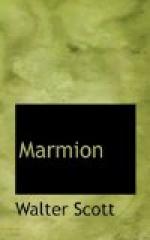’A lovely Ladie rode him
faire beside.
* * *
As one that inly mournd, so was she sad,
And heavie sat upon her palfrey slow.’
Stanza vi. With this ‘brown study,’ cp. Wordsworth’s ’Reverie of Poor Susan.’
Stanza. VII. line 114. Reference to the lion of ‘Faery Queene,’ I. iii:—
’Forsaken Truth long seekes
her love,
And makes the Lyon mylde.’
line 124. bowl and knife. Poisoning and stabbing.
Stanza VIII. Monk-Wearmouth. A monastery, founded here in 674 A. D., was destroyed by the Danes in the ninth century, and restored after the Norman Conquest. For Tynemouth, see below, 371, Seaton-Delaval, the seat of the Delavals, who by marriage came into possession of Ford Castle. Widderington. It was a ’squyar off Northombarlonde, Ric. Wytharynton,’ that showed notable valour and persistent endurance at Chevy Chase:—
’For Wetharryngton
my harte was wo,
That ever he slayne
shulde be;
For when both
his leggis wear hewyne in te,
He knyled and
fought on hys kne.’
Butler, fully appreciating this doughty champion, uses him in a descriptive illustration, ‘Hudibras,’ I. iii. 95:—
’As Widdrington,
in doleful dumps,
Is said to fight
upon his stumps.’
Widderington Castle, with the exception of one tower, was destroyed by fire. Warkworth Castle is about a mile from the mouth of the Alne, and is the seat of the Duke of Northumberland. Bamborough, the finest specimen of a feudal castle in the north of England, is said to have been founded by King Ida about the middle of the sixth century. Lord Crewe, Bishop of Durham, purchased the Bamborough estates between 1709 and 1720, and left them for charitable purposes. This charity maintains, inter alia, a national school in the village of Bamborough, and an officer to fire a cannon from the dangerous rocks every fifteen minutes in foggy weather, besides providing for the education of thirty girls within the castle walls.
Stanza ix. line 164. battled. See above, I. 4.
Stanza X. line 173. Pointed or Gothic architecture came in towards the end of the twelfth century.
Stanza xii. line 215. Suppose we = Let us suppose. This is an Elizabethanism. Cp. Macbeth, i. I. 10:—
‘Hover through the fog and filthy air,’
where hover = hover we.
Stanza xiii. line 234. Scott quotes from ‘A True Account,’ circulated at Whitby, concerning the consequences of a boar-hunt on Eskdale-side, belonging to the Abbot of Whitby. The boar, being hard pressed, made for a hermitage and died just within the door. Coming up, the three leaders—William de Bruce, Lord of Uglebarnby, Ralph de Percy, Lord of Smeaton, and a freeholder named Allatson—in their disappointment and wrath set upon the hermit, whom they fatally wounded. When the abbot afterwards came to the dying hermit, and told him his assailants




